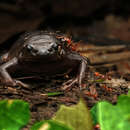en
names in breadcrumbs


Nelsonophryne aterrima és una espècie de granota que viu a Colòmbia, Costa Rica, Equador i Panamà.
Es troba amenaçada d'extinció per la pèrdua del seu hàbitat natural.
Nelsonophryne aterrima és una espècie de granota que viu a Colòmbia, Costa Rica, Equador i Panamà.
Es troba amenaçada d'extinció per la pèrdua del seu hàbitat natural.
Ctenophryne aterrima (common name: Costa Rica Nelson frog, reflecting its earlier placement in Nelsonophryne) is a species of frog in the family Microhylidae. It is found in northwestern Ecuador, the Andes of Colombia, and lowland and premontane zones of Panama and Costa Rica to about 1,600 m (5,200 ft) above sea level.[1][2][3][4]
Ctenophryne aterrima are very robust-bodied frogs with short limbs and a small, pointed head. They are moderately sized, with males growing to 61 mm (2.4 in) and females to 67 mm (2.6 in) in snout–vent length. The skin of the dorsum is smooth and uniformly black to very dark grey in color; the ventral surface is dark brown. The eye is black.[4]
Ctenophryne aterrima is a secretive and nocturnal leaf-litter species that is rarely seen.[1] Its natural habitats are humid lowland and montane forests.[1][3][4] Adults can be found under fallen logs and other debris. They breed in swamps and shallow pools on the forest floor.[1]
The species is not threatened, but habitat loss caused by agricultural development, plantations, illegal crops, logging, and human settlement, and pollution resulting from the spraying of illegal crops remain possible threats.[1]
Ctenophryne aterrima (common name: Costa Rica Nelson frog, reflecting its earlier placement in Nelsonophryne) is a species of frog in the family Microhylidae. It is found in northwestern Ecuador, the Andes of Colombia, and lowland and premontane zones of Panama and Costa Rica to about 1,600 m (5,200 ft) above sea level.
Ctenophryne aterrima es una especie de anfibio anuro de la familia Microhylidae. Se encuentra en Colombia, Costa Rica, Ecuador y Panamá.
Ctenophryne aterrima es una especie de anfibio anuro de la familia Microhylidae. Se encuentra en Colombia, Costa Rica, Ecuador y Panamá.
Nelsonophryne aterrima Nelsonophryne generoko animalia da. Anfibioen barruko Microhylidae familian sailkatuta dago, Anura ordenan.
Nelsonophryne aterrima Nelsonophryne generoko animalia da. Anfibioen barruko Microhylidae familian sailkatuta dago, Anura ordenan.
Ctenophryne aterrima est une espèce d'amphibiens de la famille des Microhylidae[1].
Cette espèce se rencontre en Colombie, au Costa Rica, en Équateur et au Panama. Elle est présente pratiquement du niveau de la mer jusqu'à 1 600 m d'altitude[1],[2].
Ctenophryne aterrima mesure environ 55 mm. Son dos est noir intense.
Ctenophryne aterrima est une espèce d'amphibiens de la famille des Microhylidae.
Nelsonophryne aterrima é uma espécie de anfíbio da família Microhylidae.
Pode ser encontrada nos seguintes países: Colômbia, Costa Rica, Equador e Panamá.[1]
Os seus habitats naturais são: florestas subtropicais ou tropicais húmidas de baixa altitude, regiões subtropicais ou tropicais húmidas de alta altitude, pântanos, marismas de água doce e marismas intermitentes de água doce.[1]
Está ameaçada por perda de habitat.[1]
Nelsonophryne aterrima é uma espécie de anfíbio da família Microhylidae.
Pode ser encontrada nos seguintes países: Colômbia, Costa Rica, Equador e Panamá.
Os seus habitats naturais são: florestas subtropicais ou tropicais húmidas de baixa altitude, regiões subtropicais ou tropicais húmidas de alta altitude, pântanos, marismas de água doce e marismas intermitentes de água doce.
Está ameaçada por perda de habitat.
Nelsonophryne aterrima là một loài ếch trong họ Nhái bầu. Nó được tìm thấy ở Colombia, Costa Rica, Ecuador, và Panama. Các môi trường sống tự nhiên của chúng là các khu rừng ẩm ướt đất thấp nhiệt đới hoặc cận nhiệt đới, các khu rừng vùng núi ẩm nhiệt đới hoặc cận nhiệt đới, đầm nước, đầm nước ngọt, và đầm nước ngọt có nước theo mùa. Loài này đang bị đe dọa do mất môi trường sống.
Nelsonophryne aterrima là một loài ếch trong họ Nhái bầu. Nó được tìm thấy ở Colombia, Costa Rica, Ecuador, và Panama. Các môi trường sống tự nhiên của chúng là các khu rừng ẩm ướt đất thấp nhiệt đới hoặc cận nhiệt đới, các khu rừng vùng núi ẩm nhiệt đới hoặc cận nhiệt đới, đầm nước, đầm nước ngọt, và đầm nước ngọt có nước theo mùa. Loài này đang bị đe dọa do mất môi trường sống.